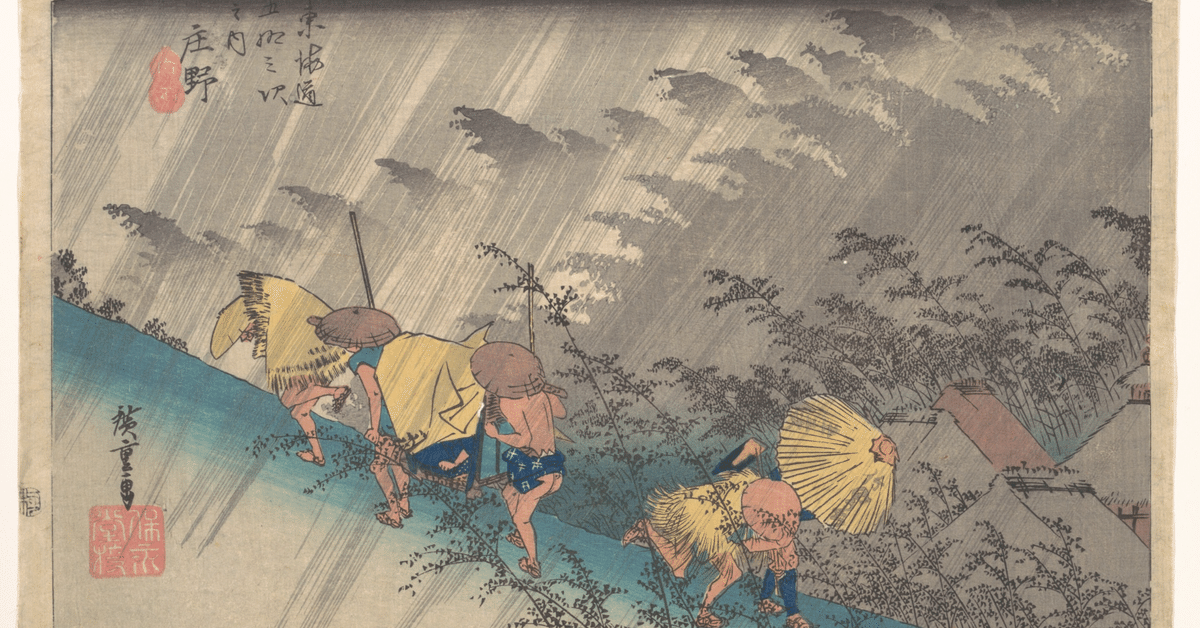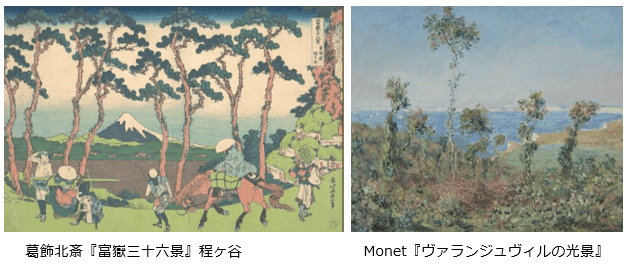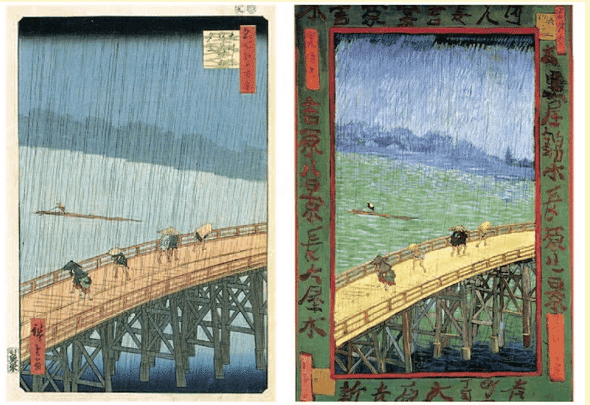
浮世絵Ukiyo-e/原画はどこに?Where are the very original paintings?
1. Ukiyo-e (Japanese woodblock prints)
Ukiyo-e, the woodblock prints that flourished in the 18th to 19th century Japan, had strong influence on Europian artists. Now, many of the Ukiyo-e masterpieces are exhibitted in major museums all over the world.
18世紀から19世紀にかけての日本で花開いた浮世絵は、ヨーロッパの芸術家に多大な影響を与えました。今日、浮世絵の傑作の多くが世界中の美術館で展示されています。
Because these masterpieces are displayed with the names of the painters, such as Utamaro, Hiroshige, Hokusai and Sharaku, I thought, for a long time, there must be the original paint drawn by those painters somewhere in the world. When I found there were no such originals at all, I was astonished.
こうした浮世絵の傑作は、歌麿、広重、北斎、写楽などの絵師の名を添えて展示されているので、私は、長い間こうした絵師が描いたオリジナルの絵画が世界のどこかに存在するものと思っていました。ですから、どこにもそんなオリジナルは存在しないと知ったときに、大いに驚きました。
Before I talk about the reason for the absence of the original paintings, I'd like to refer to the influence of Ukiyo-e on major European painters.
オリジナルが存在しない理由を話す前に、浮世絵がヨーロッパの優れた画家たちに与えた影響に触れておきたいと思います。
2. Influence of Ukiyo-e on European Artists
Claud Monet, one of the most celebrated painter of the impressionists, was strongly influenced by two major Ukiyo-e painters, Hokusai and Hiroshige.
印象派の中でも最も高名なひとりであるクロード・モネは、北斎と広重から大きな影響を受けていました。
北斎のモネへの影響/Hokusai's Influence on Monet

広重のモネへの影響/Hiroshige's Influence on Monet

広重のセザンヌへの影響/Hiroshige's influence on Cezanne
Paul Cezanne lived in the same era as Monet and was once involved in impressionism. He was also influenced by Hiroshige.
ポール・セザンヌはモネと同時代に生き、印象派に属していた時期もある画家ですが、彼もまた広重から影響を受けていました。

All the above 7 images were excerpted from this site:
ここまでの7つの画像は、次のサイトからお借りしました。
広重のゴッホへの影響
Vincent van Gogh is an painter who represents Post-impressionism. He was also influenced by Hirosige. He even replicated, by oil painting, Hiroshige's works.
フィンセント・ヴァン・ゴッホはポスト印象派を代表する画家ですが、彼もまた広重の影響を受けました。ゴッホは、油彩で広重の浮世絵の模写までしています。

The above 2 images were excerpted from this site:
上記画像は、こちらのサイトからお借りしました。
3. Absence of The Very Originals
Now, I talk about why there are no such things as the very original paintings drawn by those masters like Hokusai and Hiroshige. There were "quasi original" paintings, but they disappeared in the process of crafting woodblock prints. I say "quasi," because those paintings were in black-and-white.
さて、北斎や広重のような巨匠が描いた原画がなぜ存在しないのかを説明します。一度は〝原画のようなもの”が存在したのですが、それは木版画を作る過程で消えてしまったのです。〝原画のようなもの”と言ったのは、それが白黒で描かれていたからです。
Please access the following URL via your PC or smartphone.
https://www2.nhk.or.jp/school/movie/clip.cgi?das_id=D0005310104_00000
You'll find the site titled 「浮世絵の作り方|NHK for School」, then watch the videos uploaded there. I'm sorry it is impossible to access the videos directly from this page. The image of the URL follows.
上記のURLにPCまたはスマートフォンでアクセスしてそこにアップロードされている動画をご覧ください。残念ながら、このページで直接動画を開くことはできません。URLのイメージは次のとおりです。
The videos show crafting process of woodblock prints and tell us how the "quasi original" paintings dissapeared.
浮世絵の制作過程を描いた動画から、制作過程で原画が消えてしまうことがわかります。
The process of woodblock printing consisted of 3 stages. The first was drawing the exact image of the aimed final prints on paper. The second was making woodblocks for the final prints by carving the image on wood. The third was woodblock printing.
浮世絵づくりは三段階で構成されていました。第一は、企画している版画の出来上がり姿の正確な輪郭線を紙に描くこと。第二が、そのイメージを木の板に彫りつけて木版を作ること。第三が、木版を用いて版画を擦ることです。
An Ukiyo-e painter like Hokusai and Hiroshige, drew the exact profile line of the aimed final product, i.e. the wood print, on Japanese paper by using Japanese black ink.
At this stage, the painter had a coloring plan for the final print. But he did not show the plan on the drawing, because the coloring was done in close collaboration with a craftsman specialized in woodblock printing. Therefore, this very first drawing was in black-and-white.
北斎や広重のような絵師は、出来上がりの版画の正確な輪郭線を黒色の墨を用いて和紙に描きました。
この段階で絵師は完成した版画の彩色プランを立てていましたが、実際の彩色は木版を刷る職人との共同作業になるので、その色を表現はしませんでした。したがって、この原画は白黒でした。
There were craftsmen specialized in carving the original profile lines on wood. They were called Hori-shi, meaning carvers. A carver pasted the drawing made by the painter on wood using grue. Then, he carved the profile lines on the wood. In this process, the original drawing disappeared. The carver made one block for each color applied to the final print.
木版を掘ることに特化した彫師と呼ばれる職人たちがいました。彫師は絵師が描いた原画を糊で木に貼り付け、輪郭線を木に彫りこんで木版を作りました。この過程で、原画は消えてしまいました。彫師は、完成品に用いられるひとつの色につき一枚の木版を作りました。
The wood blocks made by carvers were handed to the craftsmen specialized in woodblock printing. These craftsmen were called Suri-shi. A woodblock printer was told by the painter the coloring plan for the final print. According to the plan, the woodblock printer applied one woodblock after another to the same Japanese paper to make the final product.
彫り師が作った木版は、木版を摺るのが専門の刷師と呼ばれる職人に手渡されました。刷師は絵師から彩色プランを指示されました。そのプランにしたがって、刷師は、同じ和紙の上に木版を一枚一枚あてがって、完成品の版画を作りました。
With this process in mind, we may think there must be the original woodbloks used for the Ukiyo-e masterpieces. But there aren't any as long as I know. The material wood used for the woodblock was so expensive that the woodblock was reused for a new print.
以上のプロセスから、浮世絵の傑作に用いられた木版が残っているように思われますが、私が知る限りでは、オリジナルの木版も存在しません。木版に用いられた木材は非常に高価だったので、次の木版画のために再利用されたのです。
Due to the above-explained circumstances, there are no such things as the very original drawings of the Ukiyo-e masterpieces.
このような事情で、浮世絵の傑作の原画はどこにも存在しないのです。
この記事が気に入ったらサポートをしてみませんか?
